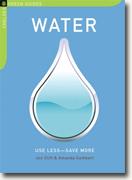Water: Use Less-Save More
Jon Clift and Amanda Cuthbert
book reviews:
· general fiction
· chick lit/romance
· sci-fi/fantasy
· graphic novels
· nonfiction
· audio books
· author interviews
· children's books @
curledupkids.com
· DVD reviews @
curledupdvd.com
newsletter
win books
buy online
links
home
for authors
& publishers
for reviewers

 |
Water: Use Less-Save More: 100 Water-Saving Tips for the Home (The Chelsea Green Guides) Jon Clift and Amanda Cuthbert Chelsea Green Paperback 80 pages September 2007 |
|
Water: Use Less-Save More: 100 Water-Saving Tips for the Home
This slim volume - consisting of short chapters such as “the bathroom,” “the kitchen,” “the garden” and so on - lists simple steps for reducing our footprint in terms of water use. The cover image is of a single blue water drop against a blue background: a crisp, clean image that perfectly suits the straightforward feel of the text. The text is brief and to-the-point; blank pages and images of water between chapters give the book a calm and meditative feel. Interesting facts are scattered throughout the book. For instance, it is startling to learn that only three percent of the water entering a home is actually consumed as drinking water, or to discover that per gallon, bottled water actually costs more than gasoline. The authors suggest storing tap water in the refrigerator to test if one can actually taste the difference between tap and bottled water. The authors make the point that older washing machines and dishwashers are notoriously inefficient in terms of water consumption - 40 gallons per cycle for older washing machines as opposed to 27 gallons per cycle for newer models, and 13 gallons per cycle for older dishwashers instead of only 4 gallons per cycle for newer machines. Older toilets likewise are inefficient in their consumption of water, using as much as 3 gallons of water per single flush. Many people on Earth have to make do with less water in an entire day. A few of the suggestions will bring out the squeamish side in any reader except for the most dedicated environmental enthusiast: the authors suggest, for instance, that people might consider peeing into a cup and pouring that “nitrogen-rich liquid” onto a compost heap to speed up the process. For the most part however, these are tips that anyone can implement fairly easily. Some of the statistics could have been expressed more clearly. For instance, the authors state that Americans use 127% more water now than in 1950. It is not immediately apparent whether this figure refers to per capita consumption or to use by the entire nation (an obvious outcome of a larger population size). But that small quibble aside, this is a very nicely done book to introduce children and interested adults to some simple ways to become aware of, and reduce, one’s water use. Originally published on Curled Up With A Good Book at www.curledup.com. © Usha Reynolds, 2009 |
| Also by Jon Clift and Amanda Cuthbert: |
|
|
|
 Click here to learn more about this month's sponsor! |
|
| fiction · sf/f · comic books · nonfiction · audio newsletter · free book contest · buy books online review index · links · · authors & publishers reviewers |
|
| site by ELBO Computing Resources, Inc. | |
 Nearly all the water on Earth is present as salty ocean water not fit for consumption or frozen as ice in glaciers, leaving precious little freshwater for human use. Much of that freshwater is currently under threat due to overuse and pollution.
Nearly all the water on Earth is present as salty ocean water not fit for consumption or frozen as ice in glaciers, leaving precious little freshwater for human use. Much of that freshwater is currently under threat due to overuse and pollution.